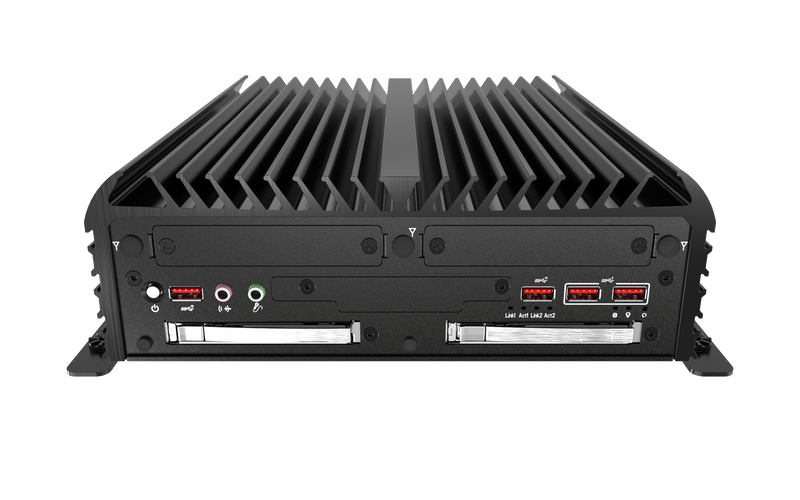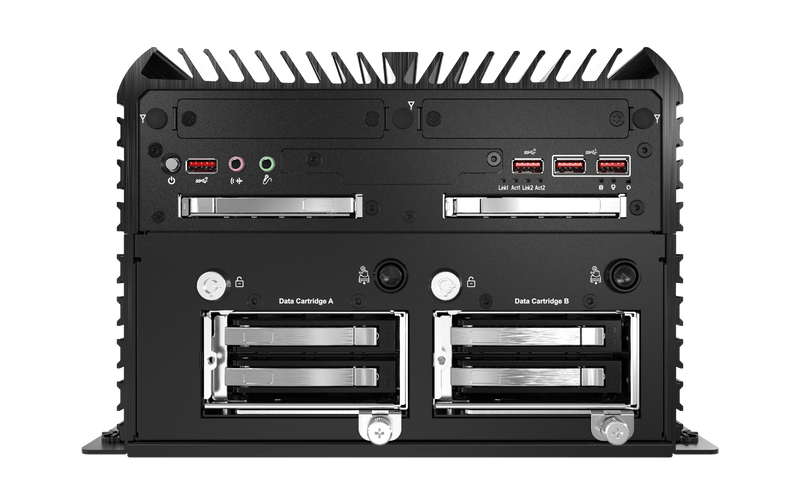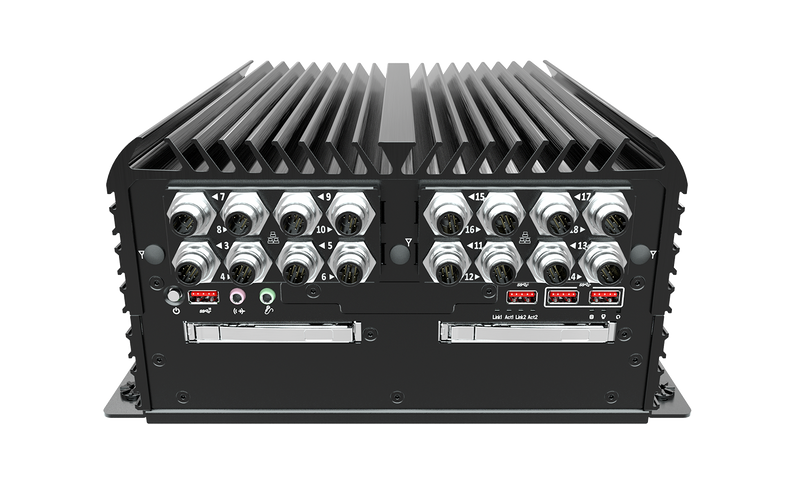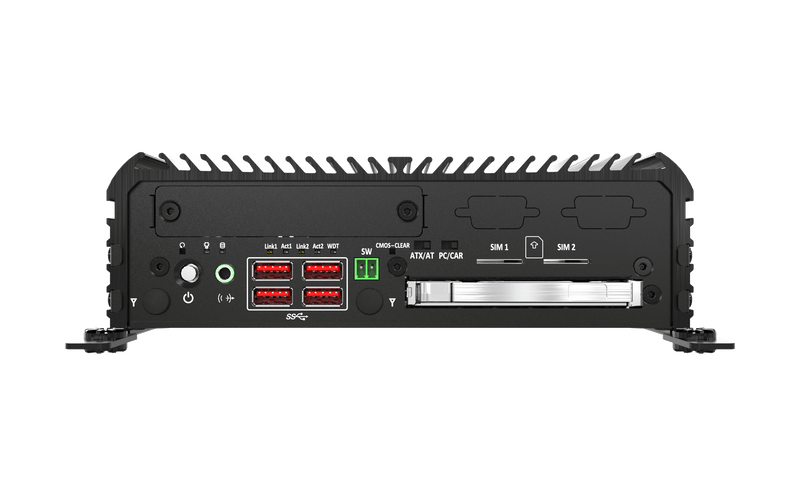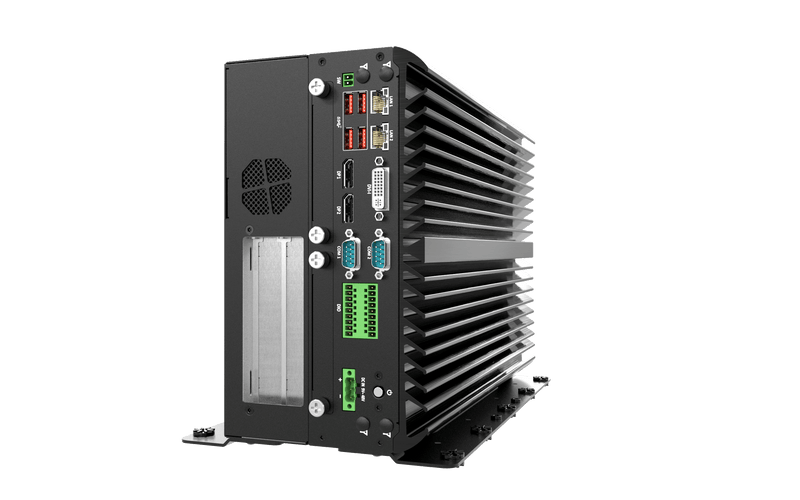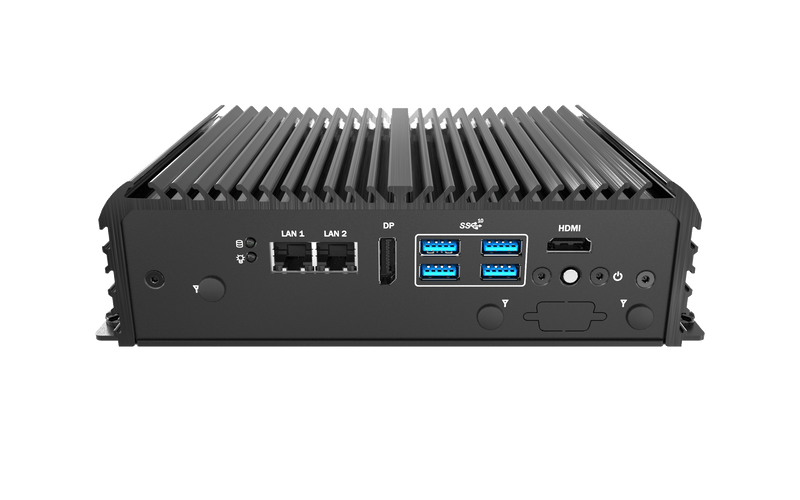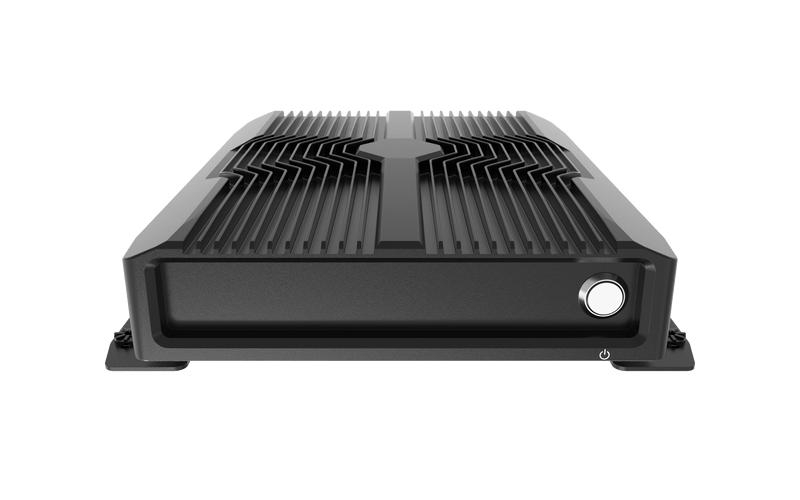What is a fanless industrial computer?
A fanless industrial computer is a fully enclosed embedded PC that utilizes passive cooling solutions to extract and dissipate heat without utilizing spinning fans or active cooling.
Unlike traditional desktop computers, fanless industrial computers leverage thermal conductivity and mechanical engineering to remove detrimental heat away from mission critical components. By doing so, fanless industrial computers ensure hardened reliability in the most challenging and harsh environments.
Discover More ...

Learn about the 7 key steps for building an industrial fanless computer for real-time processing and machine learning in the harshest edge deployments. Industrial computers help provide the mission critical foundation to manage new edge AI workloads in key automation deployments with ultimate reliability.
7 Steps Of Building A Fanless PC
Select A CPU
10W - 65W TDP
Select A CPU
Balancing power-performance-cost is essential to rugged reliability at the edge. Determine between a socket or SoC type design for power-efficient performance. Options include multi-core processors with lower TDP for better thermal regulation.
Implement SSDs
NVMe SSDs
Implement SSDs
Solid state drives (SSDs) in 2.5” and M.2 form factors use NAND flash storage that do not utilize any moving components in its construction for more reliability and endurance. NVMe options are available for high-performance read and write data storage.
Utilize Heatsinks
Ultra-Conductive Materials
Utilize Heatsinks
Fanless heatsinks are constructed with hardened materials to properly regulate component thermals with maximum reliability.
Use An Extruded
Aluminum PC Case
One-Piece Heatsink Chassis
Use An Extruded Aluminum PC Case
A hardened and robust chassis provides the necessary protection against the harshest environmental elements for thermal regulation. Industrial-grade chassis use a unique finned design for thermal regulation.
Select EDGEBoost Nodes
Performance Accelerators
Select EDGEBoost Nodes
Premio’s “EDGEBoost Nodes” power Edge AI workloads with proven transformative performance accelerators such as NVMe storage, dedicated PCIe GPU support, and power-efficient m.2 modules
Put Pieces Together
Ruggedized Design
Put Pieces Together
Consolidate and assemble all the components to construct a fully enclosed high-performance industrial fanless PC.
Test And Validate
Ensure Durability
Test And Validate
Once assembled, industrial fanless PCs are tested in our in-house test chambers to ensure top-notch quality and reliability before being deployed in applications for x86 data processing and telemetry at the edge.
Behind the Design: Passive Cooling
How Do Fanless Industrial PCs Stay Cool?

1. Thermal Conductivity
When it comes to heat regulation in industrial pcs, thermal conductivity is key in every design. Thermal conductivity refers to the ability for a particular material to conduct and transfer heat. Heat moves along a temperature gradient, from an area of high temperature and molecular energy to an area with lower temperature and energy. Through this movement, heat transfer occurs in these areas until thermal equilibrium is achieved. The transfer rate of heat, however, is dependent on the magnitude of the temperature gradient and the specific thermal characteristics of the material.

2. Mechanical Engineering
The mechanical design behind fanless industrial pcs includes rugged industrial-grade chassis, copper pipes, and heatsinks. How each of these components are used and placed will determine the design of a fanless industrial computer and ultimately its reliability in harsh environmental settings.
Heat-Removing Components in Fanless Industrial PCs

Industrial Heatsink Chassis
A fully enclosed finned chassis made of extruded aluminum protects the vital internal components within a fanless industrial PC.

Copper Heat Pipes
Copper is an excellent heat conductor, meaning it can rapidly draw heat away from the source. In a fanless CPU heatsink, copper heat pipes are in contact with the CPU and aluminum chassis. Copper pipes are also incorporated into the chassis to help distribute the heat evenly.

Aluminum Heatsinks
Although not as good as a heat conduct as copper, aluminum is a cost-effective solution at dissipating heat into the surrounding air through natural convection. Aluminum heatsinks work in coordination with copper heat pipes to reliably cool vital components without the need for a fan.

Thermal Adhesives
A chemical compound commonly used as interface between heat components. Thermal paste or thermal pads creates an air-tight seal in the space between the heatsink and component to help optimize the rate of heat transfer
Fanless. Rugged. Reliable with Passive Cooling
Fanless cooling designs and technologies are used for industrial PCs in order to remove heat, which is a natural byproduct of computing components that need to be regulated for reliable performance.
Why Go Fanless?
Benefits of Fanless Industrial Computers
Active cooling through fans introduces several threats that pose a risk to reliability for an industrial computer. Fans, themselves, are a common weak point as they are prone to failure when deployed for edge applications. Industrial computers are fanless, or passively cooled, to offer various advantages such as:
- Dust, debris, and contaminant resistance
- Shock and vibration resistance
- Wide operating temperature range
- Versatile deployment
- Low power consumption
- Silent operation
- Lengthened Reliability, Durability, & Lifecycle
Core Fanless Computing Products
Built Rugged. Built Fanless. Built Ready.
| Wide Temperature Range | -25°C - 70°C |
| Shock and Vibration Resistant | 50G and 5Grms (MIL-STD-810G) |
| Dustproof and Waterproof | IP65 – IP69K (Specific Models) |
| Wide Power Range | 9V – 48V Input |
| Power Protection | 50V+ protection |
| Certification Ready | CE, FCC, E-Mark, EMC, EN50155, and EN50121-3-2 |
Key Markets that Benefit from Fanless Industrial Computers
Why Choose Premio For Fanless Industrial Computers
Expertise In The Design, Engineering and Manufacturing for Edge Computers for industry 4.0 automation and rugged IoT deployments in remote and mobile applications
- 30+ years of extensive design expertise in rugged computing solutions focused for reliability and longevity
- Thermal simulation chambers to guarantee wide operating temperatures remote and mobile edge deployments
- Global turnkey manufacturing and support infrastructure to accelerate scalable mass deployments in rugged edge computing solutions
- Long Product Life Cycles to ensure hardware reliability
- Deep understanding of IoT technologies in computation, storage, and connectivity designed for edge computing
- Regulatory testing and compliance options for rugged edge computers in the North America Markets
The Rugged Edge Podcast
Explore Ruggedized Industrial Computers with Fanless Design
FAQ
Yes, PCs can be fanless through thermal conductivity and mechanical engineering design. By utilizing passive cooling through heatsinks, copper heat pipes, and an aluminum finned chassis, the heat generated by a PC can be cooled and dissipated out of the machine.
Fanless PCs offer a wide array of benefits compared to fan-cooled desktop PCs, especially in industrial settings. Fanless PC advantages include compact size, enhanced durability, minimal maintenance, longer MTBF (mean time between failure), power efficiency, shock and vibration resistance, dust resistance, silent operation, and much more.
A fanless PC works by utilizing passive cooling instead of moving fans to cool its internal components. For example, a fanless PC installed ultra-conductive heatsinks made of aluminum and copper heat pipes on its heat-generating processors such as the CPU. These heatsinks conduct the heat to the external chassis and allow dissipate the heat to the surrounding airflow.
It is possible for fanless PCs to overheat, depending on their CPU’s TDP and thermal designs. To avoid your fanless PCs overheating, you want to get a CPU ranging from around 10W to 65W of TDP. Having a TDP higher than that, such as CPUs with 95W of TDP, will require an active cooling solution to avoid overheating.
Fanless computers stay cool by naturally dissipating the heat conducted from the CPU to the external chassis. The heat conducted to the chassis will be cooled by the air flowing passing the computer. Hence, passively cooled the system without any fans.
Thanks to their robust passive cooling designs that eliminate moving parts such as fans, fanless PCs are incredibly safe. In contrast to standard desktop PCs, fanless PCs are known for their extreme durability and reliability against industrial environments. As a result, fanless PCs can withstand a wide temperature range, tough shocks, constant vibrations, dust ingress, water exposure, and more.
Fanless computers are better than fan-cooled computers for industrial applications that require ruggedized systems with powerful computing. Compared to standard commercial computers, fanless computers provide a balance between power and durability. In addition, various benefits come with fanless computers compared to fan-cooled computers, such as compact size, industrial grade, power-efficient, low MTBF, easy maintenance, and more.






